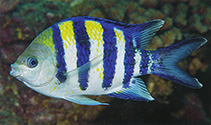| Family: |
Pomacentridae (Damselfishes), subfamily: Glyphisodontinae |
| Max. size: |
20 cm TL (male/unsexed) |
| Environment: |
reef-associated; marine; depth range 0 - 15 m, oceanodromous |
| Distribution: |
Indo-Pacific: Red Sea and eastern Africa to the Line and Tuamoto islands, north to southern Japan, south to Australia. Recorded in Bay of Islands, New Zealand (Ref. 35942). Often confused with the closely related Atlantic species Abudefduf saxatilis (Ref. 7247). |
| Diagnosis: |
Dorsal spines (total): 13-13; Dorsal soft rays (total): 12-14; Anal spines: 2-2; Anal soft rays: 11-13. This species is characterized by having the following features: body depth 1.5-1.8 in SL; forked caudal fin; colour of body blue-green dorsally, shading to silvery white ventrally; five broad bluish black bars the first just behind the head, the narrow fifth on caudal peduncle, the third to fifth extending into the dorsal fin; dorsal part of body between the first and third dark bars often yellow (yellowish hue on anterodorsal part of the body apparent especially during courtship and nesting); caudal fin without dark bands (Ref. 11441, 90102). |
| Biology: |
Adults inhabit upper edge of outer reef slopes and inshore rocky reefs. Juveniles associated with drifting seaweed (Ref. 12114, 12115). Benthopelagic (Ref. 58302). Feed on zooplankton, benthic algae, and small invertebrates (Ref. 1602). Often in aggregations (Ref. 9710) feeding at midwater or tending nests among rocks and coral ledges (Ref. 90102). In large numbers at spawning sites that are timed with large tides that carry their pelagic offspring far offshore (Ref. 48636). Oviparous, distinct pairing during breeding (Ref. 205). Eggs are demersal and adhere to the substrate (Ref. 205). Males guard and aerate the eggs (Ref. 205). Minimum depth reported taken from Ref. 128797. |
| IUCN Red List Status: |
Least Concern (LC); Date assessed: 04 November 2013 Ref. (130435)
|
| Threat to humans: |
reports of ciguatera poisoning |
| Country info: |
|
Source and more info: www.fishbase.org. For personal, classroom, and other internal use only. Not for publication.

